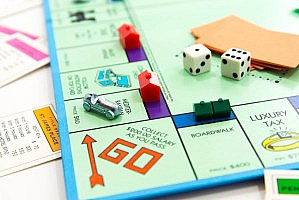
“A virtue of gaming that is sometimes overlooked by those seeking grander goals is its unparalleled advantages in training and educational programs. A game can easily be made fascinating enough to put over the dullest facts. To sit down and play through a game is to be convinced as by no argument, however persuasively presented.”
— A.M. Mood, RAND Corporation (1954)
Look no further than the Learning Lab for proof that games play an increasingly valuable role in the classroom and beyond, having long been recognized as a uniquely effective means of experiential education. But while, today, we harness technology and data to craft immersive, competitive simulation platforms, sometimes all you need to teach complex concepts is a board, some moveable pieces, and a pedagogical goal.
Take chess, for instance, which has been used for centuries to impart lessons of military strategy – its rules and competitive purpose create the conditions for tactical thinking and planning needed to checkmate one’s opponent.
Then there’s Monopoly, wherein the primary objective is to bankrupt everyone else through clever investment strategies. Hard to square that with lofty, Ivy-league business objectives, right? Yet, what is arguably the world’s best-selling board-based simulation of capitalism (and frequent ruiner of family game night) was once used as a teaching aid in Wharton economics classes. But before you cynically smirk at the very idea, there’s something you should know about the game’s hidden history: A century ago, Monopoly was not a platform to illustrate the merits of a laissez-faire system; rather, it was a way to demonstrate an alternative to the corporate rent-seeking that drives inequality.
And if that piques your interest, here’s one more overlooked historical nugget to ponder: It was Penn, not Parker Brothers, which served as the initial conduit for Monopoly‘s introduction to the masses. That’s right, folks – without storied Wharton professor Scott Nearing using the original version of the game to teach socialist principles in his campus classroom in the early 1900s, it’s likely you’d never have spent so many hours of life plotting to ruin your nearest and dearest whilst building a tiny, plastic real-estate empire manned by a Scottie dog. But, I digress…
The Landlord’s Game
Monopoly®, as we know it today, 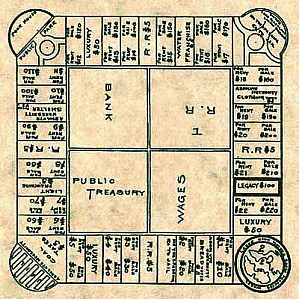 started out as a homespun folk game etched in crayon on oilcloth “boards.” Those who wanted one copied it from whomever taught them how to play – though the familiar, circuitous path of property squares, deeds, currency were quite similar to the type gathering dust on your shelf. The first prototype was patented in 1904 by little-known feminist Lizzie Magie, who tapped the hot new board-game trend as a teaching tool for demonstrating the inherently anti-social nature and general perils of monopolistic, rent-seeking capitalism. (“Lord Blueblood’s Estate” and “The Soakum Lighting Co.,” were among the many game spaces that doubled as plutocrat-derived jabs.)
started out as a homespun folk game etched in crayon on oilcloth “boards.” Those who wanted one copied it from whomever taught them how to play – though the familiar, circuitous path of property squares, deeds, currency were quite similar to the type gathering dust on your shelf. The first prototype was patented in 1904 by little-known feminist Lizzie Magie, who tapped the hot new board-game trend as a teaching tool for demonstrating the inherently anti-social nature and general perils of monopolistic, rent-seeking capitalism. (“Lord Blueblood’s Estate” and “The Soakum Lighting Co.,” were among the many game spaces that doubled as plutocrat-derived jabs.)
She called it The Landlord’s Game and, unable to find a corporate distributor, traveled around the Mid-Atlantic sharing it with left-wing intellectual circles. Like her, they were captivated by the ideology of anti-monopolist critic, author and philosopher Henry George, on which the game was based.
Charismatic and popular among progressives, George was a leading proponent of the “single tax” movement. Landowners, he argued, enjoyed unearned income (or, “rent”) from the benefits bestowed on their property by things like transit links, infrastructure, and exponential proximity to customers, suppliers and other businesses. In George’s view, the greedy rent-gouging that invariably resulted in urban areas drove up unemployment, poverty, inflation, and inequality. The fix, he and his many progressive followers believed, was replacing all other taxation with land-value levies, shifting the tax burden onto wealthy landlords while leaving labor and capital to flourish freely.
In Landlord’s, much like its modern-day successor, competitors who fell behind in the zero-sum land-grabbing race soon became crippled with debt and were mercilessly squeezed by rent, taxes and fees until finally driven penniless into the ground by a lone plutocrat who ended up with everything. The players, however, could then vote to play under juxtaposing rules that allowed them to actually cooperate – i.e., instead of paying rent to a property’s title holder when landing on a developed space, the money was put into a common pot, effectively socializing unearned income and, in turn, achieving across-the-board prosperity. Same with utilities and the railroads (or the “Slambang Trolley”), both of which become publicly owned once there was some scratch in the “Public Treasury.” Oh, and “Jail” becomes “Free College.”
By simulating the conditions, factors and outcomes of an economy potentially skewed by landlord monopolies – and offering a solution – Magie hoped to teach Georgist logic to whomever played, describing her novel initiative thusly:
“(The Landlord’s Game) is a practical demonstration of the present system of land-grabbing with all its usual outcomes and consequences. It might well have been called the ‘Game of Life,’ as it contains all the elements of success and failure in the real world, and the object is the same as the human race in general seem to have, i.e., the accumulation of wealth.”
Within a few years, Magie and her oilcloth board made a stop in the experimental single-tax community of Arden, Delaware, which is where Scott Nearing – a scholar among an assortment of bohemian and activist residents that included Upton Sinclair – became an avid player of the game.
At the time, he was earning a B.S. from Penn, followed by a Ph.D. in economics and a teaching position at Wharton in 1909. Nearing quickly became one of the School’s most popular professors, not least because of his somewhat maverick teaching style, which included: (you guessed it!) gameplay. Inspired by his own revelatory experience learning economic principles via Landlords, Nearing fashioned a board from a wooden copy that an Arden carpenter had made from Magie’s traveling model. He then taught the game in class to help students understand the reasoning behind Georgist ideology, later writing that he aimed “to show the antisocial nature of monopoly” through its play.
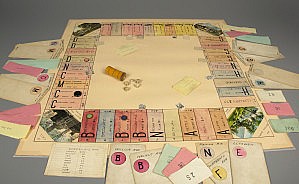 Within the context of Nearing’s socialist economics courses, the lessons gleaned from playing Landlord’s under both rule sets (i.e., being eviscerated in the former before roundly enjoying the social benefits of the latter) were presumably self-evident; but, more importantly to the history of board games, the engaging way they were taught sparked a word-of-mouth wildfire of university-level interest that soon spread throughout the Northeast.
Within the context of Nearing’s socialist economics courses, the lessons gleaned from playing Landlord’s under both rule sets (i.e., being eviscerated in the former before roundly enjoying the social benefits of the latter) were presumably self-evident; but, more importantly to the history of board games, the engaging way they were taught sparked a word-of-mouth wildfire of university-level interest that soon spread throughout the Northeast.
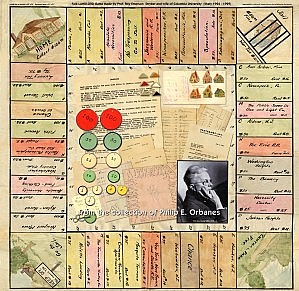 One of Nearing’s most accomplished students, Rexford G. Tugwell, went on to teach at Wharton prior to taking a position at Columbia University. There, he introduced his own homemade copy of the game to New York’s higher-ed circles (and maybe even to the White House, as Tugwell is rumored to have taught it to fellow members of President-elect Franklin Roosevelt’s “Brain Trust” upon being invited to join his elite group of academic advisors in 1932).
One of Nearing’s most accomplished students, Rexford G. Tugwell, went on to teach at Wharton prior to taking a position at Columbia University. There, he introduced his own homemade copy of the game to New York’s higher-ed circles (and maybe even to the White House, as Tugwell is rumored to have taught it to fellow members of President-elect Franklin Roosevelt’s “Brain Trust” upon being invited to join his elite group of academic advisors in 1932).
To be sure, effective as it may have been in the classrooms, teaching lounges, and (possibly) smoke-filled rooms of the day, the game was also fun – namely, the “monopolist” rendition. And it was this version (and this version alone) that truly went viral from the ripple effect of Wharton and Penn students sharing their own copies of Nearing’s board with friends and family in their hometowns and beyond.
The irony, of course, is that what was conceived as a lesson on reforming free-market capitalism only truly found success when it lost its anti-monopolistic message and was simply played as “monopoly.” Suffice it to say that outside of the educational setting, players quickly came to the conclusion that eviscerating one another was far more entertaining than the game’s intended demonstration of Georgism with its feel-good rent redistribution.
By 1930, monopoly (denoted in lowercase because it still belonged in the public domain) was making the rounds in nearly every major U.S. city. Boards continued to be hand-replicated and game tokens consisted of whatever was lying around the house (perhaps explaining the origins of that sad, last-to-be-picked “thimble” piece). This also meant that every new group of players would modify their models, personalizing them with property spaces that reflected one’s respective city streets.
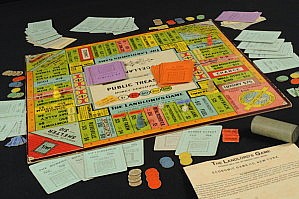 It was a copy (of a copy of a copy) of the Arden-inspired Nearing board that made its way into the hands of some crafty Quakers in Atlantic City. There, the game evolved into the version immortalized in 1936 when Parker Brothers finally let it “pass Go.” In addition to etching in their own locales (such as the Boardwalk and Park Place), they fundamentally changed it from an “adult” game to one kids could play by scrapping property auctions in favor of assigning prices to each space.
It was a copy (of a copy of a copy) of the Arden-inspired Nearing board that made its way into the hands of some crafty Quakers in Atlantic City. There, the game evolved into the version immortalized in 1936 when Parker Brothers finally let it “pass Go.” In addition to etching in their own locales (such as the Boardwalk and Park Place), they fundamentally changed it from an “adult” game to one kids could play by scrapping property auctions in favor of assigning prices to each space.
…Which brings us back to today, where the “co-opted” (to put it mildly!) modern version of Monopoly may, in fact, still be played on campus – but in dorm rooms as opposed to classrooms.
But one aspect of its heyday as a Wharton teaching tool remains, and that is the significance of using games to bridge the gap between theory and experience. And, while the Learning Lab has yet to develop a simulation that incorporates a Scottie dog with a bankroll, we do offer a host of interactive simulation experiences that are just as serious – and fun – as their ubiquitous predecessor. And, better still, if you’re interested in using one of our simulations, you don’t need oilcloth – just email our team at: learninglab@wharton.upenn.edu.


